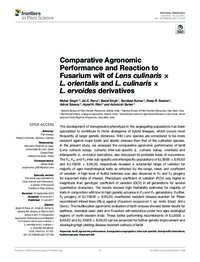Comparative Agronomy Performance and Reaction to Fusarium Wilt of Lens culinaris X L. orientalis and L. culinaris X L. ervoides derivatives.

Authors:
The development of transgressive phenotype in the segregating populations has been speculated to contribute to niche divergence of hybrid lineages, which occurs most frequently at larger genetic distances. Wild Lens species are considered to be more resistant against major biotic and abiotic stresses than that of the cultivated species. In the present study, we assessed the comparative agronomic performance of lentil (Lens culinaris subsp. culinaris) inter-sub-specific (L. culinaris subsp. orientalis) and interspecific (L. ervoides) derivatives, also discussed its probable basis of occurrence. The F3, F4, and F5 inter sub-specific and interspecific populations of ILL8006 × ILWL62 and ILL10829 × ILWL30, respectively revealed a substantial range of variation for majority of agro-morphological traits as reflected by the range, mean and coefficient of variation. A high level of fruitful heterosis was also observed in F3 and F4 progeny for important traits of interest. Phenotypic coefficient of variation (PCV) was higher in magnitude than genotypic coefficient of variation (GCV) in all generations for several quantitative characters. The results showed high heritability estimates for majority of traits in conjunction with low to high genetic advance in F3 and F4 generations. Further, F5 progeny of ILL10829 × ILWL30, manifested resistant disease reaction for fifteen recombinant inbred lines (RILs) against (Fusarium oxysporum f. sp. lentis (Vasd. Srin.) Gord.). The multilocation agronomic evaluation of both crosses showed better results for earliness, desirable seed yield and Fusarium wilt resistance under two agro-ecological regions of north-western India. These better performing recombinants of ILL8006 × ILWL62 and ILL10829 × ILWL30 can be advanced for further genetic improvement and developing high yielding disease resistant cultivars of lentil.
